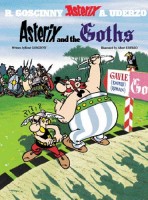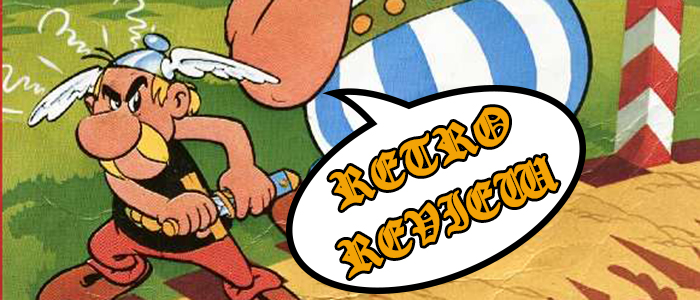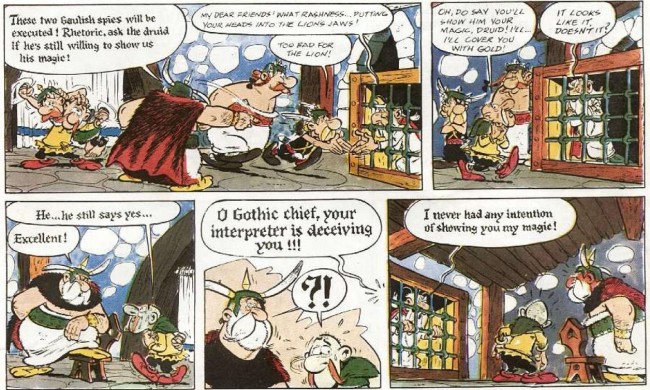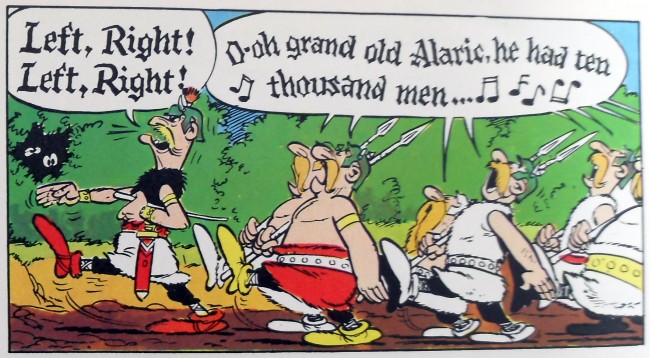What is a holiday without traditions? Though we enjoy Thanksgiving with all its bird eating and cranberry stuffing funs, the best part of the fourth Thursday in November is sitting down with my collected editions of Asterix to see what adventures the Gaul is getting into this year. And because traditions generally tie to events from the previous year, what better Asterix book to look at than Asterix and the Goths from 1963, a book that has very close ties to last year’s Retro Review of Asterix and the Golden Sickle.
SUMMARY
Pros
It was the ’60s, when it was still okay to make fun of the German and the two World wars
The art. Oh, gosh, the art.
Always fun to play Find the Bard.
They’re Goths and they speak using a Gothic font.
Cons
Dogmatix doesn’t appear for two more years.
If you’ve read all of the books, you see the familiar story pattern.
READER RATING!
[ratings] ASTERIX AND THE GOTHS
ASTERIX AND THE GOTHS
Writer: René Goscinny
Artist: Albert Uderzo
Publisher: Pilote magazine, 1963, Brockhampton Press, 1972 (First English translation)
CBPG Price: About $5.00
Previously in Asterix: Having saved their druid friend from all sorts of trouble as the celebration of the druids was in full swing, the trio (and their dog) head back to the Gaul village.
Previous Asterix Reviews
(2012) Asterix and the Golden Sickle
(2011) Asterix in Britain
(2010) Asterix in Spain
(2009) Asterix the Gaul
(2009) Asterix and Obelix’s Birthday: The Golden Book
(2008) Asterix and Cleopatra
TROUBLE! THAT STARTS WITH T AND RHYMES WITH D AND THAT SPELLS DRUID!
Though published a year apart, Asterix and the Goths ties directly to the previous book, Asterix and the Golden Sickle. In that book, Getafix needed a new sickle in order to get into the druid convention. With Getafix ready to head to the druid convention, a truce between the druids and Romans holds as druids and Gauls are allowed to pass unhindered (for the most part). However, readers quickly learn that a horde of Goths have invaded the area looking to kidnap the best druid so the Goths can invade Rome and Gaul at the same time. Curse those Goths. Getafix naturally wins first prize with his super-strength potion, leading to his capture by the Goths, and the attempted rescue by Asterix and Obelix. Being an Asterix book, there’s going to be some confusion among the Roman soldiers and our heroes, leading our heroes to be mistaken for the Goth horde. Hilarity ensues as always, with the heroes winning in the end, giving it to the Romans and the Goths before heading home for a large banquet.
This story was written in the 1963, and there are a lot of pokes and prods at the Germans for what was done during World War I and World War II. Here, when the Goths speak, they do so in a Gothic font, which is very clever. While we the reader can understand what is being said, each of the other groups (Romans, Goths, and Gauls) don’t understand each other. It makes for some great puns and plays, especially when Getafix eventually reveals he’s able to speak Goth all along.

But because of the events of World War I and II, Goscinny and Uderzo do integrate a lot of that imagery into the story – the Goths wear pickelhaube helmets, their flags adopt a similar look to the German Nazi flag (minus the swastika), and one of the chieftains looks an awful lot like Otto von Bismarck. According to Wikipeida, “Albert Uderzo has claimed regret about this in later interviews. He said the album was drawn only some years after World War II when anti-German sentiments were still vivid.” I’m not sure this detracts from the story, as it is imagery and tropes we have become used to over the years.
THIS IS WHERE IT HAPPENS
I’ve long loved Uderzo’s art style and the rounded look he gives to his characters. While Asterix and the Golden Sickle started with the familiar style, here it has become perfected; we will recognize the iconic characters from this point forward. In other books we get to see Uderzo take on large crowds of people, and while there are few moments like that here, it is the wilderness and countrysides that look incredible. I’m sure many think trees and shrubbery are not that big of a deal, but when you can add depth and dimension to a panel with very little effort using foreground and background elements like Uderzo is doing here, it is something one should pay attention to and appreciate.
BOTTOM LINE: BUY BUY BUY!
Asterix and Cleopatra will always be my favorite Asterix tale ever told (long story, see previous Retro Reviews), but I think Asterix and the Goths is now tied with Asterix and the Golden Sickle as my second favorite book in the series. There’s a solid story, with great art, characters that we love, and of course the pun filled humor that is expected from any Asterix book. Asterix and the Goths can be picked up as a stand alone book, or as part of the Asterix Omnibus Volume 1. I suggest picking it up in the multi-story volume form, as you’ll be able to enjoy three stories that give you the set-up of the world, and then two chapters tied together for a great Asterix experience. If you want to read something different and you haven’t experienced comics from Europe, Asterix is a great place to start. I’m giving Asterix and the Goths 4.5 out of 5 Stars.





